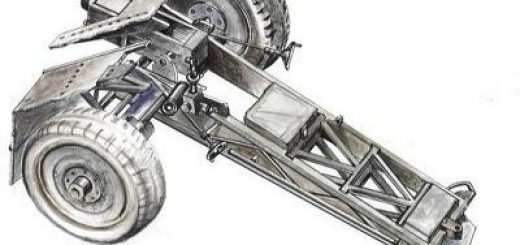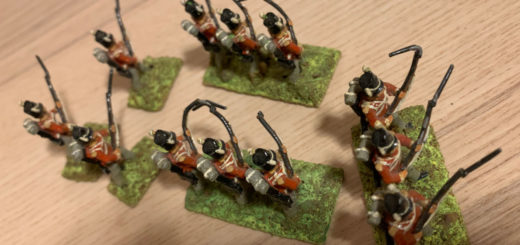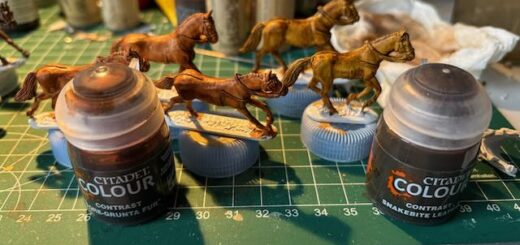Logistica in Spearhead e Modern Spearhead
Rules on logistics are applied as they have been written by Mike Reese. Our single modification is that units can be characterised by the rule Poor Fire discipline, which will cause special expenditure of ammunition.
Poor fire discipline
- 2 ammo trucks per move, when 4+ platoons are firing, or when specialist ammunition is fired (support ATGW for example)
- 1 ammo truck is spent when 3 or less platoon fire, with no specialist ammunition fired.
- ammo trucks return in game as suggested in the logistic rule, but suffer from maintenance. Throw one die per truck spent, on fail it will not return as new supply and will be lost for the game.
SUPPLY & LOGISTICS
by Mike Reese
While approved by Arty Conliffe, the following rules are intended as optional “House Rules” for scenario use: they may slow down tournament play.
The following provides a fairly simple way to simulate ammo and fuel supply using the SPEARHEAD rules. You will need both cargo and tanker truck models, or if you have no tankers, two different kinds of cargo trucks (say 1 with and 1 without canvas tops, or 4×4 for ammo and 6×6 for fuel).
Artillery battalions require ammo in order to fire. This is covered in the SH rules. To simulate ammo you can use small wooden crates or make “stacks of ammo crates” for your artillery battalions. Each time you fire a battery from the battalion you use up one turns worth of ammo. Remove it. [Note: you use 1 ammo unit if 1, 2, or all batteries in the battalion fire.]
An alternate to using the “ammo crates” is to designate a truck model as an ammo truck. If your 155mm artillery battalion has six turns of fire, then you would have six ammo trucks with the battalion. Ammo trucks must be within the command distance of the battalion command (BC) platoon to provide ammo for that battalion. Every time you fire the battalion (or any batteries in the battalion), remove one ammo truck and place it behind your start line (at the friendly edge of the table.)
Every combat battalion normally has 4 turns of ammo (2 hours of fire). Any time 4 platoons or more in the battalion conducts fire combat, one turn of ammo is used up. Firing 3 platoons or less in the battalion will not use up a turn of ammunition. Simulate the battalion ammunition supply with 4 ammo trucks.
Just as you do with the artillery ammo trucks, place the used battalion ammo truck behind your start line after it is used. Battalions with no ammo trucks left are limited to having no more than 3 platoons in the battalion fire. For counting firing, the battalion includes ALL attached units, except artillery battalions, who have their own ammo supply. When determining the battalion platoon strength for morale do NOT include ammo or fuel supply trucks.
Every combat battalion normally has enough fuel to support movement for 12 hours. Fuel supply is represented by four fuel trucks in the battalion. Use either tanker trucks or regular, but identifiable supply trucks. Each tanker truck provides enough fuel for the battalion to move for six turns. Track this with a small die placed next to the BC.
Every time the battalion has units move, adjust the number showing on the die. When it reaches six, at the end of the turn remove one tanker (fuel) truck. As with ammo trucks, place the used fuel truck behind your start line when it is used up. The four tanker trucks provide twenty-four turns (6 turns each x 4 trucks = 24) of movement. Pivoting is considered movement if a vehicle or SP pivots. As with ammo, the fuel truck must be within command control distance of the BC in order to provide fuel for that battalion.
A unit without fuel is not automatically halted from lack of fuel, but may attempt to move without any fuel trucks available (remember, movement includes pivoting). If the battalion has no fuel available, it may move OR pivot a number of platoons equal to a D6-1 die roll (0-5 platoons). Combat units without vehicles, such as an air dropped parachute infantry battalion, does not need fuel to move.
Infantry units on foot may ALWAYS move in accordance with the SPEARHEAD rules.
Ammo and Fuel trucks/units are legitimate targets for other combat units. However, the rules of engagement (priority fires and target proximity Section 7.3 of SPEARHEAD) apply to the them as well.
Ammo and fuel trucks placed behind your start line may be brought back onto the table on your next movement phase. They move as any ordinary truck would. Any ammo truck can provide ammo for any battalion, just as any fuel truck can provide fuel for any battalion.
In order to do this they must move within the command control distance of the BC of the battalion they are supplying. On the turn after this is done, that battalion has ammo to fire or six turns of movement available for each ammo/fuel truck. This will recreate re-supply.
Note that battalions will be harder to re-supply the further from their baseline they are, and battalions that use a flank march (or are parachuted behind enemy lines) will be very hard to re-supply because the re-supply trucks will have difficulty reaching them. A successful “raid” or break-through behind enemy lines will catch enemy re-supply vehicles moving up, giving such a move an operational as well as tactical mission.
For certain scenarios, you may provide more than 4 ammo and 4 fuel trucks per battalion. For example, on board field artillery providing support for an infantry offensive, might have stockpiled ammunition so they would have 8 ammo trucks, and no fuel trucks. A battalion conducting a flank march might carry additional ammo and fuel with it since the commander knows his battalion will be cut off for a time. A player involved in a static game might establish an ammo depot or fuel depot behind his lines, but closer to the front then his start line.
In this case, you would place “crates” or “jerry can pallets” for the depot (or mark it in secret on a map) and that would be the location your re-supply trucks would be placed to enter the game. Another way to show the “depot” is not just off the table, would be to require a successful D6 roll before a re-supply ammo or fuel truck could re-enter the table. How far or close the depot was to the table edge would be simulated by how hard it is to make the D6 roll (2+ would be close, 6 would be far.)
A few units may have NO re-supply trucks. The best example is a parachute battalion dropped behind enemy lines (as in D-Day, 5-6 June, 1944). The battalion would have four turns of ammo and no fuel. Ammo would be represented by ammo pallets (or counters) located with the BC. It would be expended in the normal way. The paratroops would have to rely on air drops for supplies. To qualify for this, the paratroops would have to hold an LZ (landing zone) open for drops to be made. Fly a transport aircraft to the LZ and “bomb” it with supplies.
Enemy AA can shoot at and effect the air drop as if the transport is dropping bombs instead of supplies. Supplies landing on enemy units are lost. If successful, for every transport dropping supplies you get one turn of ammo. Place an ammo counter on the BC.
A platoon which overruns (armor) or close assaults (infantry) a supply unit, either a depot (boxes/counters representing ammo units) or ammo or fuel trucks, may attempt to capture the ammo or fuel. Captured ammo can be used if your forces have the same weapons as the enemy (not often) or use the same fuel (All except Russians can use and have their fuel used, by the opposing side. US, British, Germans used gasoline in their combat vehicles, Russians used diesel.). Ammo or fuel is captured on a D6 roll of 4+, adding +1 to the die if the supply truck/depot is being close assaulted by infantry.
AMMO AND FUEL SUMMARY
All artillery and combat units must have ammunition to fire. Non- Artillery Battalions without ammunition may fire up to three platoons, and Battalions with ammunition may fire up to three platoons without using up a turn of ammunition.
All vehicles must have fuel to move or pivot. Battalions without fuel may move or pivot a number of vehicle platoons equal to a D6-1 die roll (0-5).
Ammunition and Fuel supply, either a depot or truck, must be within the normal command control distance of the Battalion Command (BC) in order to provide that battalion with ammunition or fuel.
Artillery battalions use up a turn of ammunition whenever any battery or batteries in the battalion fires in a turn. Artillery battalions without ammunition may never fire.
A unit of fuel (a fuel truck) is used up whenever any vehicles in a battalion have moved or pivoted for six turns. (The turns do not have to be consecutive.)
A used up fuel or ammunition supply truck/vehicle is returned to the game table from the friendly baseline of the player, or from any friendly supply dump located on the table. This vehicle is a re-supply vehicle.
Re-supply vehicles provide fuel or ammunition to a battalion the turn after they are within the command control distance of the BC.
Supply and re-supply vehicles DO NOT COUNT as part of the battalion’s total platoon strength for morale purposes.
Supply vehicles or dumps under close combat (SH 10.0) are either automatically destroyed, or, at the attacker’s discretion, may be captured on a D6 roll of 4+, with a +1 modifier if the close combat is an infantry assault. Captured fuel may be used by the attacker to supply his vehicles (unless Russian units or Russian fuel). Captured ammunition may only be used if the scenario designates that it is possible. (for example, one side is using captured Soviet tanks, then both captured Soviet fuel and ammunition could be used.)
Supply trucks can carry only one type of supply, either ammo or fuel, not both. Units without vehicle may either use wagons to carry supplies, or a fixed dump.



